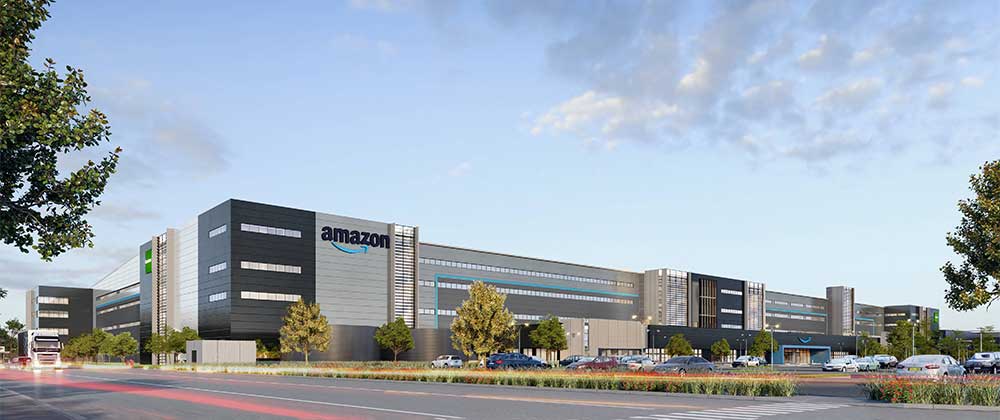As Amazon prepares to open a huge new warehouse in Sydney next year, one engineer gave create a look into the engineering behind its robot employees.
Construction of the 200,000-square-metre fulfillment centre began in June last year at Kemps Creek in Sydney’s west. Despite the pandemic, Amazon expects operations to begin by early 2022.
“With much of the key structural work already complete, our focus is currently on the extensive fit-out, testing and commissioning of our robotics and conveyance networks throughout the site,” Bartlomiej Gieraltowski, Senior Reliability, Maintenance and Engineering Manager at Amazon Australia, told create.
The structural work wasn’t an easy feat, with 13,500 t of Australian steel used in the construction of the building. For comparison, Sydney Olympic Park Stadium used just 10,500 t.
Amazon’s fulfillment centres also have specific requirements, particularly due to the robotic workforce. For example, the concrete floor within the warehouse must be completely flat to accommodate the wheels on the robots, so it is finely polished and graded to remove any possible hills or depressions.
The warehouse is likely to double Amazon’s operational footprint in Australia and could theoretically see some customers receiving orders within 12 hours of clicking ‘add to cart’.
But, like the packages the centre will eventually send out, it’s what’s on the inside that counts.
Staffed by robots
What sets Amazon’s fulfillment centre apart is its novel use of robots to pick items before shipping them to customers.
Robotic Drive Units actually pick up mobile shelves and bring them to human employees, who check and pack the items before they are sent on their way.

“In order to move around the fulfillment centre and bring our workers the products needed, the robots use AI technologies to map out a sophisticated route using 2D barcodes,” Gieraltowski said.
“Once the route is mapped out, the robot will take the correct products to the workers for either stowing or packing.”
Not only do robots do the grunt work within the warehouse, but they play a role in managing safety and optimising storage.
“Once a worker retrieves a product and releases the robot, it will stop in front of three lights and cameras, which visually inspect the storage pod using computer vision technologies to ensure no products are at risk of falling out or placed in the wrong bin,” Gieraltowski said
“During this inspection, the computer is also looking to see if there is any space in the bin which could be used for additional storage.”
The robots used in the Australian warehouse are the same as those used in warehouses in North America, Europe and Japan. And there’s a worldwide team of engineers working behind the scenes to build and develop them.
“Engineers fill critical roles in our research and development/innovation departments, software development and deployment teams for not just our robotics equipment but also our material handling and systems integration requirements,” Gieraltowski said.
Once the fulfillment centre is up and running, Australian engineers will help maintain the robots and ensure operations run smoothly.
“Our Reliability Maintenance Engineering team is made up of automation engineers, technicians and mechanical experts responsible for the maintenance procedures across the entire site,” Gieraltowski added.
Keeping humans safe
For safety reasons, human and robot employees won’t be working side by side as such.
“All the zones where our autonomous and robotic equipment operate are in safely segregated areas to reduce the interactions with our people,” Gieraltowski said.
“Most of the interaction occurs on the perimeters of these zones, where the robotic drives are ‘called’ to a certain workstation depending on the work order generated. These workstations act as a buffer zone to support interaction without moving parts and allow for our teams to interact safely.”
However, there will be occasions when specially trained team members have to enter the robot zone to repair equipment or clear debris from the field. When they do so, they must wear a ‘robotic tech vest’ — a smart device that essentially talks to the robots on the human’s behalf.
“This robotic tech vest uses advanced sciences, like AI and sensors, to send signals to other robotic drive units on the floor,” Gieraltowski said.
“Once other robotic drive units are made aware of the robotic tech vest’s presence, they automatically slow down and update their route to avoid areas where the worker currently is and will be working.”
In future, the role of robots may increase in the warehousing. The team at Amazon is constantly researching and developing new technology to improve collaboration and workflow, Gieraltowski said.
“Our teams are excited to work with, and alongside, robots and we are excited to continue increasing the technology we use at our sites while growing our global workforce,” he added.
